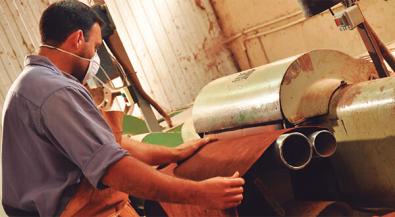Adapting, transforming and taking advantage of business opportunities is an action that many companies have taken to integrate into growing industries.
Leather tanning is a traditional activity in Guanajuato with a long history and many transformations that have allowed it to diversify and serve the automotive market.
According to the 2020 report of the Chamber of the Tannery Industry (CICUR), there are a little more than one thousand economic units belonging to the tannery sector registered throughout the country, which employ more than 12,000 people. Of these tanneries, 736 are located in the state of Guanajuato, and of these, 713 are based in the municipality of León.
CICUR estimates that 50,000 raw bovine hides are produced every day in Mexico, of which 35,000 are tanned in the state of Guanajuato, 45% of which are destined for the automotive sector.
In order to understand the current context of tanning, it is important to delve into the history of this economic activity.
It is estimated that the origins of the tannery in Leon date back to the 17th century, a few years after it was founded as a town, which until the 19th century, was a totally self-consumption and artisan activity, this tradition arose with the raising of cattle, which led to the way of marketing the product and artisans specialized in different ways of treating the leather were born.
Alfredo Arzola, General Director of the Automotive Cluster of Guanajuato (CLAUGTO), said that all companies look to the Bajío region because of the state's leather capacity.
It is estimated that there are around three or four leather and footwear factories in Guanajuato, which are responsible for the automotive industry and meet the needs of assemblers such as Honda, Mazda, GM and Toyota.
There are 24 assembly plants in Mexico, 11 of which are located in the Bajío region.
Guanajuato is home to six assembly companies and a network of 400 first- and second-tier suppliers. Of this network, it is estimated that 90% are foreign and only 10% are domestic. The state has a network of more than 3,000 national SMEs that provide services, processes and commercialization of different types of services ranging from transportation, logistics, engineering, maintenance, civil works, among many others.
He commented that a vehicle has more than 30 thousand parts, and it is estimated that the seat has around 700 parts, depending on the model and version, and it is in this component that leather is required.
"In Mexico there are Tier 1 companies that specialize in the production of automotive seats, and they are the ones who buy leather parts in Leon," said the automotive specialist, who added that in order to transform and be part of this sector, companies must change their culture and everything depends on their age, their generation and corporate change.
It is estimated that Guanajuato has a capacity to produce one million vehicles, but in 2021 670 thousand were produced; and in 2022 production is expected to be close to 800 thousand cars.
It is expected that one out of every four cars is manufactured in Mexico. And 25% of production is in Guanajuato and 60% of national production is in the Bajío (which includes San Luis Potosí, Aguascalientes and Guanajuato).


























